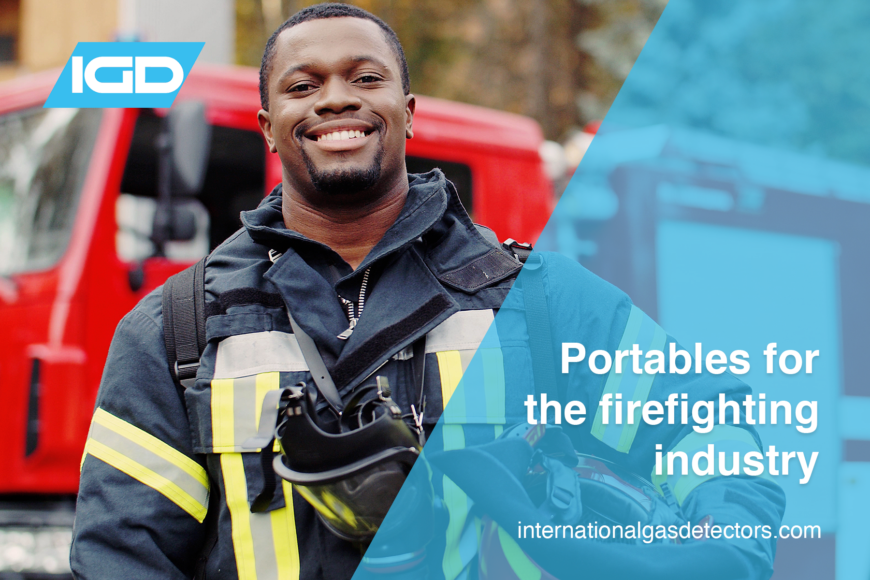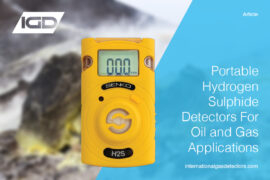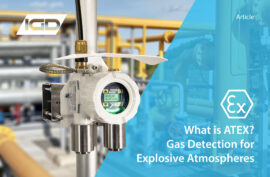Portable detection for the firefighting industry
Working in the firefighting industry means you can encounter a plethora of hazards in your day-to-day life. This including the obvious dangers such as fires and smoke. However, precaution needs to be taken into the gas hazards firefighters may encounter. This can range from the common gas hazards, such as the toxic twins – CO and HCN, to more unique hazards like benzene and hydrogen sulphide. All of these being very dangerous. Therefore, it is vital to have adequate detection for the hazards you are encountering. Due to the range of gases it is possible to encounter, there is an equating number of portable gas detectors to be utilised in this application. This includes handheld multi gas detectors such as the MGT as well as handheld VOC monitors like the NEO. Read on to find out more about the hazards of firefighting and IGDs detectably better solutions.
What gases are present to firefighters?
As previously mentioned, there are many different hazards likely to be present in the firefighting industry. Most commonly, Hydrogen Cyanide (HCN), Carbon Monoxide (CO) and Carbon Dioxide (CO2) are produced through combustion, with O2 depletion going hand-in-hand with these.
CO in firefighting
Carbon monoxide is the most known and common gas produced as a product of combustion. This gas is highly poisonous has a STEL of 100ppm. Thus, becoming over exposed can happen very quickly. Over exposure to this gas can cause poisoning and long term health issues, such as heart attacks and seizures. This gas is common in almost all fires, being characterised by having no taste or smell. Thus, making it impossible to be detected by our 5 senses. Therefore, the only sufficient way to monitor for this gas is by implementing a handheld multi gas detector.
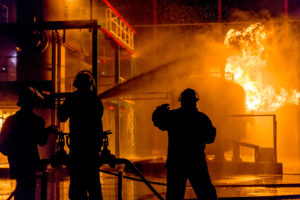
Firemen using water from hose for fire fighting
Hydrogen Cyanide in firefighting environments
Hydrogen cyanide (HCN) is an extremely poisonous gas, commonly found in combustion with CO gas. With a STEL of 4.5ppm, this highly toxic gas is most commonly produced from the combustion of synthetic materials. So, it can be a massive hazard in a wide range of applications, as synthetics are found in a majority of furniture, clothing, electronics and various other common objects. Making it vital to provide firefighters with a handheld multi gas detector with a HCN sensor to ensure their safety.
Both CO and HCN are almost always found together in firefighting applications, known by their nickname: the Toxic Twins. You can find out more about the dangers of the Toxic Twins here.
Combustible Gas Hazards
Flammable gases may also be present in a firefighting environment, as these are commonly the causes of combustion. Between 2007 and 2011, US fire departments responded to 51,600 fires caused by the ignition of flammable gases annually. Common flammable gases include Propane, Methane, and Hydrogen. Gases like Propane and Methane are more common in home fires, as these are used for heating and cooking purposes. Hydrogen is now a potential new hazard as it is more frequently being utilised as a domestic and industrial fuel gas. And with a flammability level of 4% volume in the air, an explosive atmosphere can occur rapidly. Detection when entering areas containing these gases is essential to the health of personnel. Therefore, implementing a handheld multi gas detector is the most effective way to mitigate these hazards. As there could be a range of combustible gases present along with products of combustion.
Unique gases found in firefighting
Some unique gases that need to be considered by firefighting personnel include Benzene and other VOCs, in addition to HF.
Benzene is common in crude oil, thus is present in the creation of plastics and synthetics, as well as in oil refining. This is flammable, explosive, and toxic and thus may be present in fires at factories, fuel stations or can even be possible in more residential areas. If inhaled at a high enough level, this gas can be fatal, causing death in some cases. With a TWA of 1ppm, over exposure can occur rapidly. Therefore, having a Benzene specific handheld VOC monitor on hand is essential.
Benzene specific handheld VOC monitors can also be used for alternative reasons in firefighting scenarios. These monitors can be utilised in the arson investigation process to help investigation teams determine whether or not a fire accelerant was used. Examples of this include Kerosene or Butane. These can help conclude what may have started the fire and thus, for domestic fires in particular, decide whether or not it was an act of arson. Therefore, Benzene specific handheld VOC monitors can be massively beneficial in almost all aspects of firefighting.
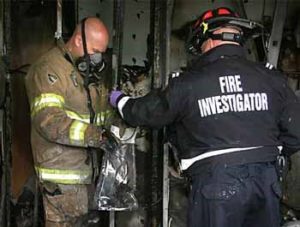
Fire investigation team on the scene
Firefighters are more frequently dealing with lithium ion battery fires as these are becoming more commonly used in cars. Lithium ion batteries produce Hydrogen fluoride when burning. This, can be extremely harmful to personnel dealing with fires and civilians in the surrounding area. This is due to the high toxicity of the gas, with a STEL of 3ppm. Therefore, competent HF detection can be lifesaving to the firefighters handling these hazards.
Gases found in alternative firefighting scenarios
Fire services also respond rescue scenarios, such as gas leaks and hazmat spills. Thus, they may need to utilise handheld VOC monitors and handheld multi gas detectors to ensure their safety in response.
Gas and chemical leaks can be common across the UK. Occurring in areas such as swimming pools and refrigeration plants, they are detrimental to the safety of the public. Recent instances of this include the London Olympic pool leak, causing 29 people to be entered into hospital from Chlorine poisoning. In addition to the Ammonia refrigeration leak at Carlsberg’s brewery in Northampton. Leading to 22 people, including 2 police officers, to be entered into hospital. As you can see, both Chlorine and Ammonia are extremely hazardous to the health of people. Therefore, firefighters entering these areas need to be vigilant for the hazard at hand. The best way to do this is to implement a specific gas detector, such as a single gas ammonia detector or a chlorine detector.
In hazmat scenarios, handheld VOC monitors or handheld multi gas detectors will need to be used, depending on what substance has been spilled. This will need to be utilised by the team cleaning up the spill, with common hazmat substances such as hydrocarbons emitting a wide variety of dangerous gases, such as CO2. Thus causing a massively hazardous environment. Hydrocarbons can also leave residue after the spill is initially cleaned up, so gas hazards are still potentially present. Hazards present in hazmat scenarios can, however, vary depending on the spill. So contact the team at IGD here to find out more about the equipment needed for your application.
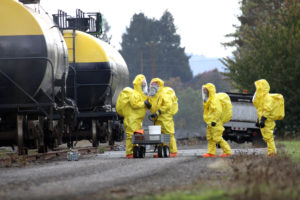
Hazmat team members responding to a chemical spill
Portable detection solutions for firefighting
IGD have over 100 years of industry experience and expertise, as well as being the official partner, servicer, and distributor for mPower and Senko in the UK. Thus, guaranteeing your emergency response team is getting the best qualified service and expert advice on your Senko and mPower portables. IGDs expert team offer free training for all portables detectors, so there is no need to worry about this extra cost upon purchase. Read on to find out the details of the ideal handheld multi gas detector and handheld VOC monitors for firefighting services.
The ideal handheld multi gas detector
Handheld multi gas detectors such as the Senko MGT-P contain the most common combination of sensors for multi gas monitors (FLAM, CO, H2S and O2). This type of handheld multi gas detector is ideal for more common emergency response, such as house and restaurant fires and confined space rescue. This is because it can detect all flammable gases present in any fire, as well as being able to accurately monitor oxygen depletion levels and CO level. For confined spaces, it can detect H2S which is in abundance in these areas. Thus, reducing the need for multiple clunky portables. The MGT is the most durable handheld multi gas detector on the market, making it perfect for emergency response scenarios. This monitor contains long life sensor technology as well as clear and concise alarms, so reliability and competency is ensured no matter what environment you are in.
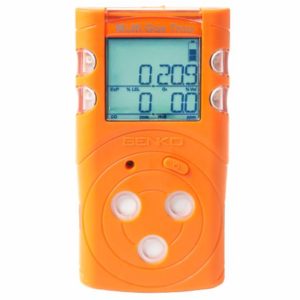
the MGT Gas Detector
For more complex gas combinations, handheld multi gas detectors such as the POLI are perfect. The POLI Model offers the widest range of plug and play sensors available on the market, including HF sensor, ideal for fires with more exotic gas hazards, such as Lithium ion battery fires. The POLI also offers a unique man down alarming system with wireless tracking of each user. This is vital in emergency response teams, as personnel who have collapsed within a dangerous area can be easily found and located through the alarm and tracking.
PID NEO – Handheld VOC monitor
The NEO handheld VOC monitor is great for accurate VOC detection, providing monitoring for up to 700 VOC gases in any environment. As previously mentioned, this is particularly ideal for arson investigation and hazmat response as it can detect gases in hard to reach areas and detect leaks without endangering personnel. This handheld VOC monitor has the most stable PPB level on the market, ensuring accurate and reliable detection of your VOC’s. This reliable monitor is significantly lighter weight than others on the market and is durable for a variety of areas, making it ideal for movement in and out of fire scenes. mPower’s NEO also comes with a rubber boot for extra protection, especially important in hazmat areas.
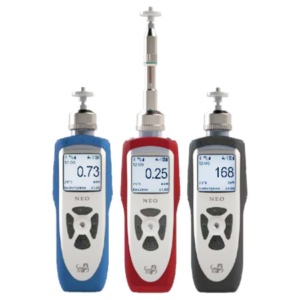
PID NEO Portable Family
IGD can also offer a Benzene specific handheld VOC monitor for use in firefighting scenarios. Offering all of the outstanding benefits of the NEO handheld VOC monitor in a Benzene specific format. Similar to the NEO, the NEO benzene comes with an outstanding long battery life and easy charging capabilities. With the capability of charging via a Micro USB, allowing for easy charging on the go from any location. Due to Benzene monitors being used across a wide range of applications, it is essential they are able to record on the go. The Benzene NEO can do just that! Ensuring no data is lost, with a capacity of over 240,000 data points.
To find out more about what IGD can offer in terms of detectably better firefighting, arson investigation or emergency personnel protection, contact our team today here or visit our products page for more details on our range.
References
- https://iffmag.mdmpublishing.com/knowing-your-atmosphere/
- https://www.london-fire.gov.uk/about-us/services-and-facilities/techniques-and-procedures/hazardous-material-response-capability/
- https://www.internationalgasdetectors.com/gases/flammable-gases/
- https://www.internationalgasdetectors.com/gases/ammonia/ – refrigeration in restaurants
- https://www.internationalgasdetectors.com/gases/carbon-monoxide/
- https://www.internationalgasdetectors.com/gases/hydrogen-cyanide/
- https://www.internationalgasdetectors.com/gases/volatile-organic-compounds/
- https://www.internationalgasdetectors.com/gases/formaldehyde/
- https://www.internationalgasdetectors.com/gases/hydrogen-h2/
- https://www.internationalgasdetectors.com/gases/nitrous-oxide/
- https://www.internationalgasdetectors.com/gases/oxygen/
- https://ohsonline.com/Articles/2020/04/01/Protecting-Firefighters-from-Invisible-Hazards.aspx
- https://www.annualreviews.org/doi/pdf/10.1146/annurev.pu.13.050192.001055/ pg 153 and 158 (health effects)
- https://www.mpowerinc.com/wp-content/uploads/2019/02/TA-Note-5-Gas-Detectors-for-Firefighters-and-Hazmat-Teams-v.1.1.pdf
- https://www.senkoeu.com/fire-services
- https://assets.publishing.service.gov.uk/government/uploads/system/uploads/attachment_data/file/458052/HPA-CHaPD-004_for_website.pdf
- https://www.nfpa.org/-/media/Files/News-and-Research/Fire-statistics-and-reports/Fact-sheets/FiresStartingGasFactSheet.pdf
- https://pubchem.ncbi.nlm.nih.gov/compound/Acetone#:~:text=It%20occurs%20naturally%20in%20plants,the%20environment%20than%20natural%20processes.
- https://www.internationalgasdetectors.com/gases/hydrogen-fluoride/
- https://www.hse.gov.uk/pubns/priced/eh40.pdf

